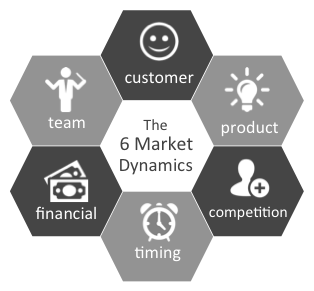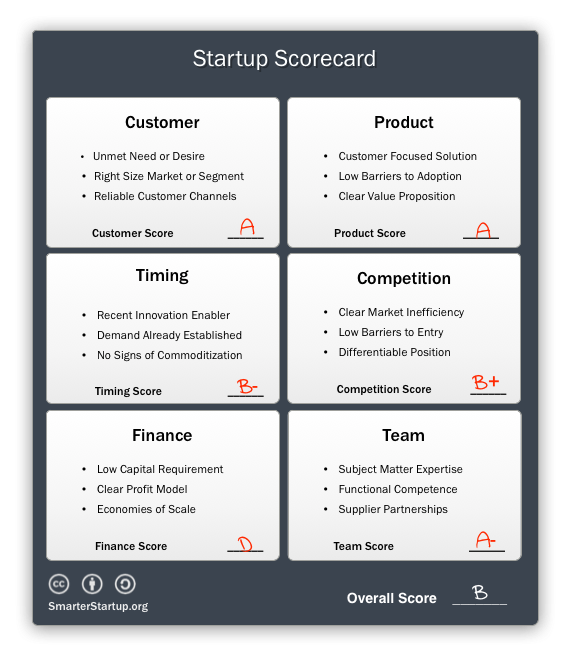Evaluating Market Dynamics
How do you know whether a product idea is going to succeed if you build it and take it to market? If you’ve ever been part of a startup, or if your organization has launched a new products, you know how precarious the effort can be. Sure, there is Lean methodology for discovering product-market fit, but that is a step that necessarily should come after researching and validating your market. Lean is only going add efficiency to your process if you’ve started with a solid understanding of the market and built your starting hypothesis upon that understanding.
To that end, my co-author and I from the book The Smarter Startup, have created a couple resources that should prove useful. The first is a conceptual model called the 6 Market Dynamics. Here we identify the criteria that must be considered when studying a market: The customer, product, timing, competition, financing, and team. Each of these aspects should be studied to evaluate the viability of the market and your ability to create value and to be competitive.

Let’s start with the goal of identifying market opportunity. What we’re really looking for is some inefficiency in the market which suggests that customer needs or desires are not being satisfied. Or put another way value, defined as benefit minus cost, is not being delivered efficiently to the customer. By walking through each of these market dynamics we can start to get a sense of whether the market is efficient and whether our available financial and team resources will be adequate to bring more value to the market.
Since that time, I have also built a more actionable framework called the Product Opportunity Evaluation Scorecard which introduces 3 heuristics for each of the 6 market dynamics. Heuristics are applied guidelines that are used in a subjective context, where empirical principles may not be practical. They’re most commonly known in the fields of HCI and User Experience design as demonstrated by Jacob Neilson’s Usability Heuristics. The Startup Scorecard provides a similar framework for validating market opportunity in consideration of 6 market dynamics: the Customer, Product, Timing, Competition, Finance, and Team. We’ve defined 3 heuristics for each market dynamic, as a means for assessing the viability of an opportunity across each of the 6 market dynamics.

Using the Startup Scorecard, assign a letter grade (A-F) for each of the 6 market dynamics represented on the scorecard, based on your evaluation 3 heuristics provided for each market dynamic. This provides a practical framework for evaluating the opportunity and identifying strategic weaknesses which may signal market difficulty. The beauty of this approach is that a lot of difficulties that you may identify through Lean iteration can actually be identified very early on, just by spending a bit of time to evaluate the market strategically. there are also longer-term challenges that may not even be apparent during product-market testing that will show up here (such as timing and imminent market consolidation).
Conclusion
The real benefit of tools like the 6 Market Dynamics and the Startup Scorecard is to have an objective and holistic set of criteria by which you can take a critical look at a startup or opportunity, rather than relying on instinct or a couple disparate pieces of advice you’ve gleaned from discussions or blogs – and hopefully avoiding the trap of Lean testing endless ideas or ‘pivots’ that you could have much more efficiently validated before writing a single line of code.
As the hype around Lean Methodology dissipates, and the tool settles into to its rightful place in the Product owner tool belt – its important to remember that Lean is a terrific tool for taking a hypothesis and developing Product-market fit; but it is not a reasonable replacement for strategy or basic market research. Hopefully, the tools we’ve introduced here will help Product owners more easily step through those prerequisite steps in the process.
This article was originally posted on MindTheProduct.com.